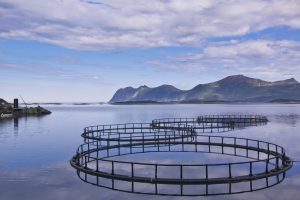Introduction to Aquaculture
Aquaculture is growing animals and plants in a water environment. Aquaculture is a broad category that encompasses freshwater and saltwater marine systems. Some operations have systems that are “closed,” involving just fish production and “open,” involving other systems such as hydroponics. Aquaculture business has been growing by more than 60% in the last 10 years. It is the world’s fastest developing source of animal protein. Aquaculture is a neat way to understand biological cycles and how we can learn so much from nature by observing how wastes become another’s resource for food or nutrients.
In this section, you will learn about the different types of systems, how to create your own, and leave remembering the value of a closed loop system of which reuses another’s waste.
Aquaculture has been set up in the open water sources such as the ocean. The next generation of aquaculture, by contrast, is land-based urban aquaculture situated in warehouses it uses a recirculating system for the water, with no discharge or antibiotics.
At the bottom of the page we have included some questions to help you with your learning and please use the forum to answer the forum questions or to post questions of your own to the community learning with you.

General information
Pros and cons
Find out more about the benefits and challenges to aquaculture according to the World Wildlife Foundation or SeaWeb.


Careers in Aquaculture
What Does a Career in Aquaculture Look Like?
Typically, the structure of a aquaculture personnel ranges from technician to lead biologist or manager.
Country by Country breakdown of Aquaculture Statistics
What Does Aquaculture Look Like in Your Country?
Aquaculture looks very different from country to country and even from town to town. The above link offers information sorted by country and sector, but here is an overview provided by an American university of what aquaculture often looks.

Chart Outlining Different Types of Aquaculture
CHART IS COMMING SOON!!!!!
Informational Videos:
Aquaponics-type Aquaculture:
In the The Outdoors TV – “Aquaculture” (July 7, 2014)
Around Carolina – “RDM Aquaculture – Fowler, IN”
News Reports:
Reuters – “Aquaculture system promises eco-friendly fish farming future”
Promotional Videos Ltd – “Aquaculture – Northland, New Zealand” (January 30, 2014)
NOAA “Exploring U.S. Aquaculture” (September 19, 2012)
WorldFish – “Aquaculture is changing lives in Bangladesh”
humanitarian side to aquaculture:
Around Carolina – “RDM Aquaculture – Fowler, IN”
the Working Waterfront – American Aquaculture in the 21st Century” (June 2, 2016)
Presentations:
Nature Farms “Aquaculture – Missing Link in Circular Production Systems – Nature Farms” (September 14, 2016) Data Heavy
TEDxProvidence by Perry Raso– “The Importance of Sustainable Aquaculture in Our Future” (May 25, 2016)
World Science Festival – “Aquaculture: The Next Generation”
DIY Resources:
DIY Tilapia farm:
Backyard Aquaculture Fish Farm:
DIY venturi, a few easy builds for aquaponics, aquaculture or hydroponics
extra DIY link
build your own recirculating fin fish aquaculture system:
http://web.utk.edu/~rstrange/wfs556/html-content/08-design.html
Food For Thought:
